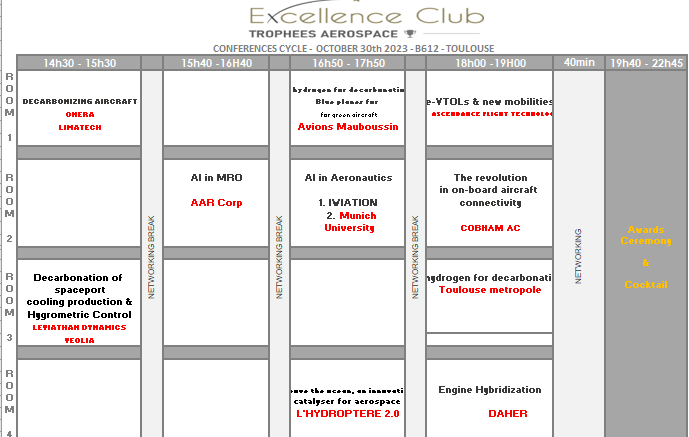From 2.30 to 3.30 PM
- GREEN AERONAUTICS : structural weIght reduction, wing aeronautic innovations for decarbonizing aircraft
Peter will present ONERA research activities towards decarbonizing aviation.
The presentation focuses on the various activities performed within the ONERA scientific departments in order to converge towards an ultra-efficient aircraft. The studies cover improvements of aerodynamics efficiency, aircraft weight reduction and propulsive efficiency increase. In addition, details about future configuration explorations are provided. Last, advanced testing capabilities supporting the development of future aircraft are presented.
By Peter Schmollgrober, ONERA
From -6 to 7 PM
- MAKING A HYBRID AIRCRAFT IS NOT THE SAME AS HYBRIDISING AN AIRCRAFT
At a time when the aeronautics industry is joining forces to meet environmental challenges, many debates are focusing on aircraft configuration and propulsion technologies, which are merely means to an end.
With the objective of decarbonising usage, aircraft manufacturers need to implement solutions to control the entire value chain, beyond the scope of their traditional activities. Upstream, they need to concern themselves with the availability of new (low-carbon) energies, and downstream, with the uses associated with air mobility. Data and digital technologies are at the heart of these issues.
Based on the lessons learned from the ECOPULSE hybrid electric technology demonstrator, DAHERcan now project its first product by 2027 to meet all these challenges.
By Christohe Robin, DAHER
- e-VTOLs AND NEW MOBILITIES : which use, which market size, landscape ?
– Future of autonomous air service in Europe and worldwide
By Bruno Ferran, Co-founder Ascendance Flight Technologies
From 4.50 to 5.50 p.m
- ARTIFICIAL INTELLIGENCE IN AERONAUTICS: which one, which use, which applications, challenges, certification ?
1.Generating a cockpit-warning for a runway incursion at small aerodromes with the help of artificial intelligence: At small aerodromes, especially at uncontrolled ones, dangerous situations can occur, when aircrafts, vehicles or persons enter the runway without authorization. With the help of artificial intelligence, those situations can be identified. New avionic functionalities make it possible to generate a cockpit-warning during approach. The concept will be presented with current results as well as an outlook for further work will be given.
By Pedro Bauer, Munich University of Applied Sciences Bachelor
2.IMROVING AVIATION SAFETY WITH LESSONS LEARNED: Safety is number one priority in aviation. Global statistics shows that safety in aviation is overall continuously improving.
However human factors is one of the main reasons for today’s incidents or accidents.
The investigations focus on root cause analysis with safety recommendation to be executed to avoid similar incident or accident.
This provides a look inside the possibilities how communication on lessons learned factors, especially on human factors can be done, to further improve aviation safety.
By Marcus Bauer, CEO IWIATION
From 3.40 to 4.40
- MRO AND ARTIFICIAL INTELLIGENCE: WHICH DATA, WHICH PURPOSE (MRO and predictive maintenance), During this session, you will review what AI is really, what are the applicable field of operation in MRO, training, structural analysis post surface damage or structural damage, predictive maintenance.
Will it be a game changer, or a tools that will replace others and enhance the efficiency of the MRO? How to apprehend AI?
Should we be scare of it, and go with it, ensuring humans remain master of the game over machine.
By Pascal Parant, VP Marketing Corporate, AAR.Corp
From 6 to 7 pm
- THE REVOLUTION IN ON-BOARD AIRCRAFT CONNECTIVITY The connectivity on-board the aircraft is undergoing a revolution.
The progresses in connectivity technologies – compactness, reliability, cybersecurity, quality of data- allow substantial enhancements in the communications between the aircraft and its environment –air traffic control, airport, other aircraft, airline operations.
This development will enable augmented capabilities that will contribute to optimizing the trajectories, optimizing the aircraft drag and maneuverability, optimizing the pilot workload and optimizing the safety and the quality of the exchanges between the pilot and his environment.
This development is based on :
1. Smaller or integrated antennas
2. Next generation audio/radio management systems
3. next generation satellite communication (satcom) systems (note : this point is subject to a specific presentation – see below)
By Nicolas Bonleux, CEO, Cobham Aerospace Communications
From 2.30 to 3.30 pm
- DECARBONATION OF SPACEPORT COOLING RODUCTION AND HYGROMETRIC CONTROL
Cooling roduction represents 2/3 of the electricity consumption of the French Guyana Space Center. In addition, the main refrigerant used on the space port is R134A which is a potent greenhouse gas. Each year, the mass of R134A used for refilling the refrigerant tank can be counted in tons. With a GW of 1500, the GHG emissions due to leakage of HFC refrigerant can be counted in thousand of tons.
In a context of global warming, mastering GHG emissions due to cooling equipment is key for the sustainability of the operation of the Space Port.
Leviathan Dynamics has installed a first ilot of a chiller that is using only water as refrigerant, allowing the complete phase-out of HFC refrigerant and also potentially reducing energy consumption by 30%.
By Karino Kang, President & co-founder, LEVIATHAN DYNAMICS
From 2.30 to 3.30
- HYDROGEN FOR DECARBONATION : manufacturing ways, availability in quantity, cost, benefit for environment, distribution network, etc
By Charlotte Voisin, Toulouse Metropole
- H2 DIRECT COMBUSTION IN ENGINE: principle, which use ?, which challenges (weight, cooling, sizing ..) ?

